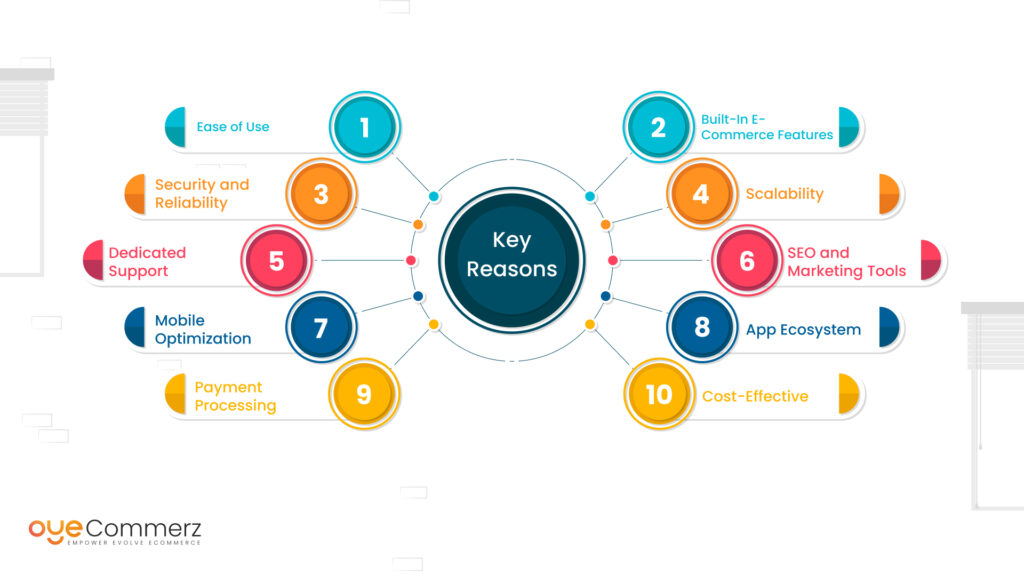Transitioning from WordPress to Shopify marks an exciting step in streamlining your e-commerce processes. As businesses expand, choosing a solution that aligns with growth potential, UX, and customization becomes crucial. Shopify is widely recognized as a preferred choice for online merchants, providing superior flexibility, data protection, and user-friendliness. In this guide, we will delve into the transformative impact of this migration, discuss the benefits, and provide practical tips to facilitate a smooth transition.
1. Top Reasons to Transition from WordPress to Shopify
WordPress, paired with WooCommerce, has served countless online stores. Nevertheless, as companies expand, issues like reliance on plugins, security vulnerabilities, and complex setups often obstruct progress. Shopify, designed explicitly for e-commerce, eliminates these concerns with an comprehensive, intuitive solution. Statistics supports this shift—Shopify hosts over 4.4 million websites worldwide, with a reported 10% boost to sales performance for many businesses post-switch.
2. Key Benefits of Shopify for E-commerce Success
Shopify’s powerful platform is tailored for expanding businesses. Its notable benefits include:
- Effortless Design Flexibility: Shopify offers over 80 professionally designed themes.
- Built-in Features: Features like Shopify Payments and built-in SEO save time and effort.
- International Expansion: Currency versatility and localization features empower businesses to reach global markets.
Additionally, Shopify boasts an uptime rate of 99.98%, ensuring your store remains accessible.
3. Preparing for WordPress to Shopify Migration
Before migrating, evaluate your current store. Analyze inventory details, customer details, and SEO performance. Resources such as Shopify’s Migration Kit or external tools help ease the transition. Create a comprehensive plan, making sure all resources—item details, media files, and blog content—are optimized for transfer.
4. The Importance of Accurate Data Migration
Data migration is a cornerstone of a smooth transition. When migrating from WordPress to Shopify, focus on:
- Product Information: SKU, item summaries, and groupings.
- Client Information: Emails, order history, and custom fields.
- SEO Optimization: Preserve meta tags, URLs, and redirects to avoid SEO losses.
Use apps like LitExtension to streamline data transfer while minimizing errors.
5. Tailoring Your Shopify Store to Fit Your Brand
After the move, customizing your Shopify store ensures it aligns with your brand. Take advantage of Shopify’s intuitive page builder to design pages effortlessly. Shopify's themes are mobile-responsive, providing a smooth user experience across platforms—a key point, given Shopify migration services 74% of e-commerce traffic is generated by mobile visitors.
6. Maintaining SEO During Migration
Search engine optimization is crucial for maintaining your visibility during migration. Shopify excels in SEO with clean URL structures, preloaded features, and smooth content management. Make sure you:
- Implement 301 redirects for existing links.
- Shopify CMS migration Enhance updated content with targeted phrases.
- Leverage plugins like Plug in SEO to monitor performance after the switch.
7. Post-Migration Testing
Once the migration is complete, run detailed checks.
Check: - Website speed (Shopify boasts faster speeds compared to WordPress).
- Payment integration reliability and transaction flow.
- Adaptability across devices.
Testing ensures your store delivers a smooth shopping journey from the start.
8. Case Study of a Successful Migration
One such migration success story is Gymshark, a fitness apparel brand that transitioned to Shopify. After the switch, the company saw a 60% increase in mobile sales and significantly lowered site downtime. This showcases the potential of Shopify in driving e-commerce growth.
9. Overcoming Common Migration Issues
Migration is not without obstacles, such as information accuracy and adjusting tailored features. However, Shopify’s extensive assistance and external professionals simplify the process. Partnering with experienced Shopify developers ensures a trouble-free transition.
10. Starting Your Journey with Shopify
Switching from WP to Shopify represents a strategic approach to e-commerce. By focusing on growth, simplifying management, and enhancing the customer experience, Shopify empowers businesses to thrive in competitive markets.
Final Thoughts
Switching from WordPress to Shopify is a strategic move that can significantly boost your e-commerce success. With a robust migration plan, the right tools, and professional guidance, you can achieve new success milestones.
Excited to start the journey? Reach out today to learn how our Shopify migration services can revolutionize your e-commerce platform. Contact us now, or consider: Can your business afford to miss out on Shopify’s growth potential?
